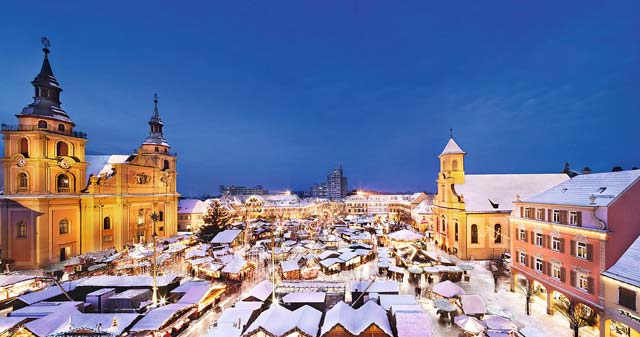
In Germany, Christmas casts a magical spell on cold and dark winter days. It’s a time to celebrate long-standing family traditions, regional customs and values.
During their everyday routine, Germans pause and sit back to enjoy Christmas cookies, meet with family and friends at home or go to the many local Christmas markets for a mug of hot Glühwein (mulled wine) and Christmas punch.
The holiday season in Germany officially begins with Advent. Historically, Advent is the season in which Christians await the birth of Jesus Christ on Christmas day.
One Advent tradition in Germany is the Advent wreath. The wreath is typically made out of fir tree branches and decorated with dried fruits, pine cones, glittering Christmas ball ornaments or stars. Four candles represent the light brought into the world by Jesus Christ. A candle is lit each Sunday until Christmas Eve.
Most people in Germany also begin to bake Christmas cookies during the Advent season.
During the 20th century, the Advent calendar was introduced in Germany to help count down the days before Christmas Eve (“Heilig Abend” or holy evening). The typical Advent calendar is made out of paper and has 24 doors, one to open each day from Dec. 1-24. Children will find holiday season-inspired images or chocolate behind the paper doors. Some calendars also have boxes or small bags filled with presents to open each day.
Dec. 6 marks the birthday of Nikolaus, Bishop of Myra (known today as Turkey), and is celebrated in Germany as St. Nikolaus’ Day. Legend has it that on his birthday, Nikolaus would don his precious bishop’s coat, fill a big sack with nuts, apples, tangerines and honey cake, and load it on the back of his donkey.
He then picked up his staff and walked along the streets, giving away the food to those he met.
Today, children place their boots outside their doors on the night of Dec. 5 in hopes that St. Nikolaus will leave some goodies in their shoes. Early on Dec. 6, most children find their boots filled with candy, gingerbread, toys, tangerines and nuts. In other cases, St. Nikolaus visits children during the day in kindergartens and schools, or makes a grand entrance during the evening hours at home.
He is often accompanied by his helper, Knecht (servant) Ruprecht. Knecht Ruprecht carries all the presents for the children in a big sack on his back and has a birch switch hanging from his belt for those children who misbehaved during the year.
While St. Nikolaus typically has a long white beard and wears a red coat with a red hat, Knecht Ruprecht wears a brown or black coat and has a long gray beard.
In Germany, Christmas Eve is celebrated with close family. Traditional-ly, the gift exchange takes place in the afternoon, followed by a festive meal.
The choice of meal varies from goose with red cabbage, dumplings or potatoes, to fish, or, typical for Swabia, Saitenwürstle (sausages) with potato salad.
Many people in Germany visit extended family and friends on Dec. 25 and 26, called the first and second Christmas days.
The exchanging of gifts takes place under the festively decorated Christmas tree. Mainly fir trees or silver spruces are used as Christmas trees and are typically put up during the Advent season or a few days prior to Christmas Eve. Germans typically take their Christmas trees down by Epiphany on Jan. 6.
In the words so many Germans will be saying to each other this month: “Fröhliche Weihnachten” (Merry Christmas)!
